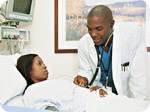By Celia Farber
Joyce Ann Hafford was a single mother living alone with her thirteen-year-old son, Jermal, in Memphis, Tennessee, when she learned that she was pregnant with her second child. She worked as a customer service representative at a company called CMC Call Center; her son was a top student, an athlete and musician. In April 2003, Hafford, four months pregnant, was urged by her obstetrician to take an HIV test. She agreed, even though she was healthy and had no reason to think she might be HIV positive. The test result came up positive, though Hafford was tested only once, and she did not know that pregnancy itself can cause a false positive HIV test. Her first thought was of her unborn baby. Hafford was immediately referred to an HIV/AIDS specialist, Dr. Edwin Thorpe, who happened to be one of the principal investigators recruiting patients for a clinical trial at the University of Tennessee Medical Group that was sponsored by the Division of AIDS (DAIDS)—the chief branch of HIV/AIDS research within the National Institutes of Health.
The objective of the trial, PACTG 1022, was to compare the “treatment-limiting toxicities” of two anti-HIV drug regimens. The core drugs being compared were nelfinavir (trade name Viracept) and nevirapine (trade name Viramune). To that regimen, in each arm, two more drugs were added—zidovudine (AZT) and lamivudine (Epivir) in a branded combination called Combivir. PACTG 1022 was a “safety” trial as well as an efficacy trial, which means that pregnant women were being used as research subjects to investigate “safety” and yet the trial was probing the outer limits of bearable toxicity. Given the reigning beliefs about HIV's pathogenicity, such trials are fairly commonplace, especially in the post-1994 era, when AZT was hailed for cutting transmission rates from mother to child.
The goal of PACTG 1022 was to recruit at least 440 pregnant women across the nation, of which 15 were to be enrolled in the University of Tennessee Medical Group. The plan was to assign the study's participants to one of two groups, with each receiving three HIV drugs, starting as early as ten weeks of gestation. Of the four drugs in this study, three belong to the FDA's category “C,” which means that safety to either mother or fetus has not been adequately established.
Joyce Ann Hafford was thirty-three years old and had always been healthy. She showed no signs of any of the clinical markers associated with AIDS—her CD4 counts, which measure the lymphocytes that are used to indicate how strong a person's immune system is, and which HIV is believed to slowly corrode, were in the normal range, and she felt fine. In early June 2003, she was enrolled in the trial and on June 18 took her first doses of the drugs. “She felt very sick right away,” recalls her older sister, Rubbie King. “Within seventy-two hours, she had a very bad rash, welts all over her face, hands, and arms. That was the first sign that there was a problem. I told her to call her doctor and she did, but they just told her to put hydrocortisone cream on it. I later learned that a rash is a very bad sign, but they didn't seem alarmed at all.”
Hafford was on the drug regimen for thirty-eight days. “Her health started to deteriorate from the moment she went on the drugs,” says King. “She was always in pain, constantly throwing up, and finally she got to the point where all she could do was lie down.” The sisters kept the news of Hafford's HIV test and of the trial itself from their mother, and Hafford herself attributed her sickness and nausea to being pregnant. She was a cheerful person, a non-complainer, and was convinced that she was lucky to have gotten into this trial. “She said to me, ‘Nell’ —that's what she called me—‘I have got to get through this. I can't let my baby get this virus.’ I said, ‘Well, I understand that, but you're awful sick.’ But she never expressed any fear because she thought this was going to keep her baby from being HIV positive. She didn't even know she was in trouble.”
On July 16, at her scheduled exam, Hafford's doctor took note of the rash, which was “pruritic and macular-papular,” and also noted that she was suffering hyperpigmentation, as well as ongoing nausea, pain, and vomiting. By this time all she could keep down were cans of Ensure. Her blood was drawn for lab tests, but she was not taken off the study drugs, according to legal documents and internal NIH memos.
Eight days later, Hafford went to the Regional Medical Center “fully symptomatic,” with what legal documents characterize as including: “yellow eyes, thirst, darkening of her arms, tiredness, and nausea without vomiting.” She also had a rapid heartbeat and difficulty breathing. Labs were drawn, and she was sent home, still on the drugs. The next day, July 25, Hafford was summoned back to the hospital after her lab reports from nine days earlier were finally reviewed. She was admitted to the hospital's ICU with “acute and sub-acute necrosis of the liver, secondary to drug toxicity, acute renal failure, anemia, septicemia, premature separation of the placenta,” and threatened “premature labor.” She was finally taken off the drugs but was already losing consciousness. Hafford's baby, Sterling, was delivered by C-section on July 29, and she remained conscious long enough not to hold him but at least to see him and learn that she'd had a boy. “We joked about it a little, when she was still coming in and out of consciousness in ICU,” Rubbie recalls. “I said to her, ‘You talked about me so much when you were pregnant that that baby looks just like me.’” Hafford's last words were a request to be put on a breathing tube. “She said she thought a breathing tube might help her,” says Rubbie. “That was the last conversation I had with my sister.” In the early morning hours of August 1, Rubbie and her mother got a call to come to the hospital, because doctors had lost Hafford's pulse. Jermal was sleeping, and Rubbie woke her own daughter and instructed her not to tell Jermal anything yet. They went to the hospital, and had been there about ten minutes when Joyce Ann died.
http://x.imeem.com/WVNJglkX1_

 Dear NaturalNews readers,
Dear NaturalNews readers,
























